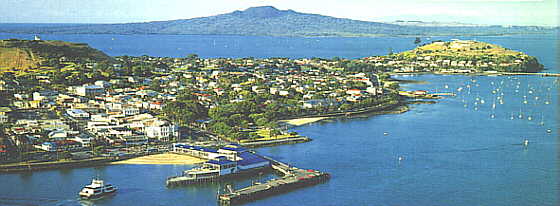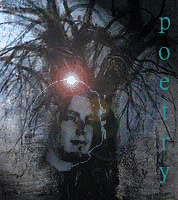|
(Published in JAAM 1996)
As if I had been in a fever. I am walking on Narrowneck Beach. The saline air is moist and thin, and the sea bubbles and foams like rock. Across on the volcano, pohutukawa trees clutch at the igneous rocks. Once a tidal island, now a peninsula. They wrapped rock about the narrow neck, slicing the sea. The grieved tides advance and no longer meet. A bloodless calm. An extinct chill. I carve sleep in the sand. I dream:
From
this promontory
2 The city is venous. In each pulse, a hot fluid of people. Each tower breathes in. On a side street, a church inhales its congregation. The stones are basalt blocks quarried from Rangitoto. I step inside. There is no view of the ocean.
We
crawled on the black, sharp stones
The candles are lava-hot. The red wine is crimson scoria. The city is vulcanous. Beneath each squat grassy mount lies thick black coagulate rock. 3 The throat-cut harbour. There, at the tip of the peninsula, Cambria once bled her unwholesome salty air in malarial fever. The pahoehoe lava curdled with the sea and clotted fast to thicken a thin-necked peninsula. Cambria, drawn off, fell into an extinct chill.
Sharp
stone shock and sea
4 Iím tired and watch the sea from the window of the bus. The sanguine sun on the plasma yellow sea. A bloodless muttering old woman sits next to me. Her salty blooded breath. The bus turns and passes Narrowneck Beach. Children crawl on stones. She remembers unexpectedly:
Crawling on those rocks when small
I step off the bus and walk across the Neck. Beneath me, thick black coagulate rock. 5 As if in a fever they placed guns about the head of the peninsula, in fear, in expectation of an invasion which would never come. To protect the city. A uniformed old man still guarded the harbour from his vantage point on Rangitoto, years after the war. In 1950 he was finally convinced by the navy that there was no risk of attack. The guns stayed their sanguinary urge to burst men. They rust extinct now on North Head. 6 The volcano is blood-thick. Its crust is a rubble of black basalt blocks, bubble-hot sharp. Pohutukawa trees bloom scoria-red. They breathe in saline air. The island is sacred. Walking on a black-ash beach, I watched the volcano bleed into the sky. The red wine rain. Rangitoto. And black sharp rock. The venous sea.
On
Motutapu he
7 Cambriaís gone, quarried away for scoria. Her sisters remain, cool and grass-covered. A soft crust of moist soil combed over the lava. A bloodless old couple wander about grassy Mt Cambria reserve. Far beneath them, cautery and scoria. Myself a wan figure at the end of the peninsula. In the sea, a sick sickle-celled anaemic moon. I dream of the old woman:
I lay pale with blood-blacked back
Michael
Arnold
|

